This article was medically reviewed by Shari Forschen, NP, MA. Shari Forschen is a Registered Nurse at Sanford Health in North Dakota. Shari has worked in healthcare since 1996 and her expertise lies in acute care bedside nursing on a medical oncology floor. She received her degree from Medcenter one College of Nursing in 2003 and her Family Nurse Practitioner Masters from the University of North Dakota in 2014. Shari is a member of the American Nurses Association.
There are 17 references cited in this article, which can be found at the bottom of the page.
wikiHow marks an article as reader-approved once it receives enough positive feedback. In this case, 92% of readers who voted found the article helpful, earning it our reader-approved status.
This article has been viewed 100,231 times.
Research suggests that bed sores are most common in people who have limited mobility, especially persons who are bedridden or who use a wheelchair.[1] Bed sores (also called ulcers) are caused by the pressure against your skin when you stay in one position for too long. Bed sores are a common worry, but they're also preventable with proper care. Experts agree that you can prevent bed sores by changing positions, keeping the skin clean, and supporting a healthy immune system.[2]
Steps
Preventing Bed Sores
-
1Keep turning the body. When you are taking care of a bedridden individual, make sure you move the body every two hours. You don't have to move him to another room or piece of furniture, but the position should be different enough that the same area of the body is not under pressure.
- For example, turn the patient from the right side to the left. You can also use a pillow to prop him up.
- If you are stuck in bed yourself, you can invest in a trapeze bar and reposition yourself. This only works if you are physically strong enough to use such a device.
- If the patient has certain kinds of injuries, such as those to the spinal cord, make sure he is moved in such a way as to not cause more injury.[3] [4]
-
2Cut down on shear. One way that bed sores develop is through pressure on the skin due to sliding. The patient may lose traction when she is elevated, which causes the bedding and the skin to move in opposite directions. For example, the skin of the tailbone may stay in place while the body slides down the bed. The pressure on the skin can cause bed sores over time.Advertisement
-
3Buy a special mattress. There are special mattresses on the market that can reduce the amount of pressure put on the body. This will help the patient avoid having any one area as a focus of pressure. You can also buy an air-filled or water filled mattress to help reduce the pressure on the patient's body. Look for these at a medical supply store so you can purchase a medical-grade mattress for this purpose.[7]
- If you are unsure on which to buy, ask your doctor for recommendations for the particular situation.
- You can also use a mattress pad or cushions to help protect the bony areas of the patient.[8]
-
4Provide proper nutrition. Malnutrition can contribute to the development of bed sores.[9] This can develop especially quickly in patient's who are unable to take sufficient calories orally and/or willingly. Make sure the patient eats balanced meals of fruits, vegetables, whole grains, and lean meats.[10]
- Make sure you check the dietary restriction of any patient you deal with. Each patient is assessed individually for his specific nutritional needs.[11]
-
5Stay hydrated. To keep the skin of the patient healthy, make sure that she stays hydrated. If you are not sure how much water she should have, ask the doctor to advise you based on the patient's specific needs. Different illnesses and conditions require different hydration needs.[12]
- You can also use juice to stay hydrated and keep up nutrition as well.[13]
-
6Identify early signs of bed sores. Bed sores happen over a period of time. Early signs can include: non-blanching erythema or a purple or maroon localized area of discolored, intact skin, which may be painful, firm, mushy, boggy, or a different temperature than adjacent tissue. This indicates early stage of tissue damage or probable wound formation.[14]
Treating Existing Bed Sores
-
1Watch for signs of infection. Once bed sores have been identified, they should be watched for signs of infection. This includes fever, areas of redness along the border of the ulcer sore, drainage of pus, and a soft texture beneath the skin indicating that the tissue beneath is likely filled with pus or rotting away.[15]
-
2Bandage the sore. Once infection in identified, ask the patient's doctor for appropriate treatment methods. Typically, the doctor will advise tight gauze moistened with normal saline. The gauze should be removed one to two times daily. This action removes dead skin, which allows healthy tissue to form and the wound to heal. Depending on the size of the ulcer, healing will take around four to six weeks.[16]
- Dry gauze should be packed on top of it. The skin around the sores should not be wet like the wound.[17]
- The type of dressing will depend on the size and depth of the of the wound and the amount of drainage.[18] Talk to the doctor about the best dressing and technique to use for the particular patient.
-
3Use particular cleaning products. Never use hydrogen peroxide or betadine on bed sores to clean the healing skin. Instead, always use mild soap and warm water to clean the wound. If that is not possible, use a mild no-wash cleanser to clean the area.[19]
- The doctor may order an enzymatic or chemical dead skin removal solution to facilitate healing. The removal of the dead skin through surgical means can be necessary in many cases if there is a lot of dead tissue.[20]
- Other methods for cleaning bed sores include enzymatic agents, maggots, or high-pressure water jets.[21]
-
4Use antibiotics. If there is infection that sets into the sores, a systemic antibiotics might be prescribed. This will help heal the infection and the skin as well. Intravenous antibiotics may be necessary if a bone infection is present, which is not uncommon in bed sores on the pelvic region.[22]
Understanding Bed Sores
-
1Learn the risk factors. Patients at risk are those who have limited mobility and spend a great deal of time in bed or sitting. This can be at home, in a nursing home, a hospital, or in a retirement home. The causes for being bedridden include spinal cord injuries, strokes, progressive neurological disease, fractures, comas, and those in intensive care units (ICU).[23]
- Around 70% of bed sores occur in patients over the age of 65. The remainder occur in younger patients who suffer from issues that leave them in the bed.[24]
-
2Look for the causes. Bed sores develop from the abuse of the skin due to immobility, as well as prolonged exposure to moisture. Bed sores lead to a decreased quality of life as well as increased mortality and morbidity.[25] They are localized injuries to the skin or underlying soft tissue, usually overlying a bony prominence. This includes the bottom, the ankles, the heels, or the hip bones. However, they can occur at the site where a patient is hooked to a ventilator and are constantly rubbed against by the equipment or tubing.
- They develop due to unrelenting pressure to the area, which blocks the flow of oxygen and nutrients to the affected area, causing cell death.[26]
- This can happen despite a caregiver's best attempt at preventing them. However, some cases develop due to inattention and elder abuse.[27]
- Elder abuse is a public health concern despite being grossly under-reported and under-detected.
-
3Recognize the stages of bed sores. The severity of bed sores ranges from stage I to stage IV. The state of the bed sore affects the health of the patient and changes the kind of treatment necessary.[28]
- Stage I is when the sore is an area of redness over a bony prominence, that will not turn pale when pressed with your finger. The redness will not go away or get better.[29]
- Stage II entails the loss of partial skin thickness to the outermost layer of skin. Often a shallow wound with a pink-red base will occur at the site with a clear fluid filled blister overlying this shallow wound.[30]
- Stage III consists of a wound with total loss of the thickness to the outer layer of skin, which cuts into the underlying layer of skin. The wound is not too severe, does not continue into the muscle layers and bone, and the tendons and muscles are not exposed.[31]
- Stage IV is when all the outer and inner layers of skin are gone, exposing the underlying muscle layers. The bones, tendons, and muscles may be exposed. If there is no underlying fat in the area, the sores, such as those on the ears or nose that occur from respiratory devices, are classified stage IV as well.[32]
Warnings
- Patients who are older should be watched more carefully. Younger patients often can speak up for themselves and understand more about the prevention of bed sores.⧼thumbs_response⧽
References
- ↑ https://medlineplus.gov/pressuresores.html
- ↑ https://www.hopkinsmedicine.org/health/conditions-and-diseases/bedsores
- ↑ Blaustein, Daniel, and Javaheri, Ashkam. Pressure Ulcers: Prevention. Evaluation and Management. American Family Physician 2008, 78(10), 1186-1194
- ↑ https://msktc.org/sci/factsheets/skincare/Preventing-Pressure-Sores
- ↑ https://www.hopkinsmedicine.org/health/conditions-and-diseases/bedsores
- ↑ Blaustein, Daniel, and Javaheri, Ashkam. Pressure Ulcers: Prevention. Evaluation and Management. American Family Physician 2008, 78(10), 1186-1194
- ↑ https://medlineplus.gov/ency/patientinstructions/000740.htm
- ↑ Cooper, Karen. Treatment of Pressure Ulcers Critical Care Nurse. 2013, 33 (6)
- ↑ Cooper, Karen. Treatment of Pressure Ulcers Critical Care Nurse. 2013, 33 (6)
- ↑ https://www.ncbi.nlm.nih.gov/pmc/articles/PMC5930532/
- ↑ Blaustein, Daniel, and Javaheri, Ashkam. Pressure Ulcers: Prevention. Evaluation and Management. American Family Physician 2008, 78(10), 1186-1194
- ↑ https://medlineplus.gov/ency/patientinstructions/000147.htm
- ↑ https://www.med.umich.edu/1libr/Nutrition/DietPressureUlcers.pdf
- ↑ https://my.clevelandclinic.org/health/diseases/17823-pressure-injuries-bedsores
- ↑ https://medlineplus.gov/ency/patientinstructions/000740.htm
- ↑ https://www.nhs.uk/conditions/pressure-sores/treatment/
- ↑ https://familydoctor.org/condition/pressure-sores/
- ↑ https://familydoctor.org/condition/pressure-sores/
- ↑ https://medlineplus.gov/ency/patientinstructions/000740.htm
- ↑ https://my.clevelandclinic.org/health/diseases/17823-pressure-injuries-bedsores
- ↑ https://www.nhs.uk/conditions/pressure-sores/treatment/
- ↑ Blaustein, Daniel, and Javaheri, Ashkam. Pressure Ulcers: Prevention. Evaluation and Management. American Family Physician 2008, 78(10), 1186-1194
- ↑ https://www.hopkinsmedicine.org/health/conditions-and-diseases/bedsores
- ↑ Blaustein, Daniel, and Javaheri, Ashkam. Pressure Ulcers: Prevention. Evaluation and Management. American Family Physician 2008, 78(10), 1186-1194
- ↑ White, E Foy, Chu, Flock, Petra, and Struck, Bryan. Pressure Ulcers in Long-Term Care Clinics in Geriatric Medicine. 2011, 27 (2), 241-258
- ↑ Cooper, Karen. Treatment of Pressure Ulcers Critical Care Nurse. 2013, 33 (6)
- ↑ Burnell, Jason, Achenbaum, Andrew W, and Murphy, Kathleen Pace. Prevention and Early Identification of Elder Abuse. Clinics in Geriatric Medicine, 130 (4), 743-759
- ↑ https://msktc.org/sci/factsheets/skincare/Recognizing-and-Treating-Pressure-Sores#fsmenu2
- ↑ https://msktc.org/sci/factsheets/skincare/Recognizing-and-Treating-Pressure-Sores#fsmenu2
- ↑ https://msktc.org/sci/factsheets/skincare/Recognizing-and-Treating-Pressure-Sores#fsmenu2
- ↑ https://myhealth.alberta.ca/Health/pages/conditions.aspx?hwid=zm2442
- ↑ https://myhealth.alberta.ca/Health/pages/conditions.aspx?hwid=zm2442
About This Article
To prevent bed sores, turn your body to a different position every 2 hours so you're not putting too much pressure on one area. Depending on your injury, you may need someone to help you change positions. Also, make sure your bed isn't elevated more than 30 degrees when you're lying down so you're not sliding down the bed, which can cause friction that leads to bed sores. You should also stay hydrated and eat a balanced diet to keep your skin as healthy as possible. For more advice from our Medical co-author, like how to treat existing bed sores, scroll down!


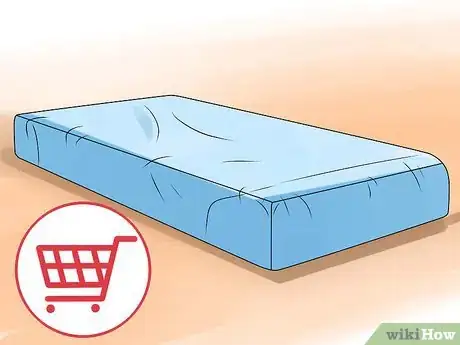


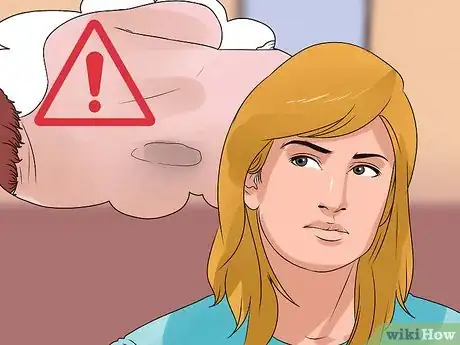

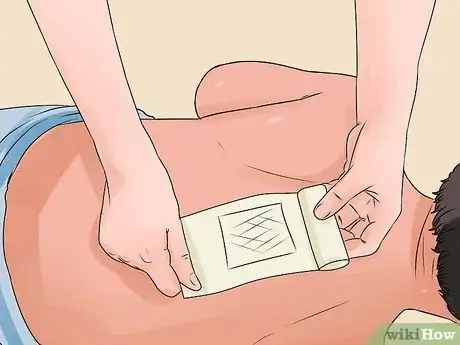
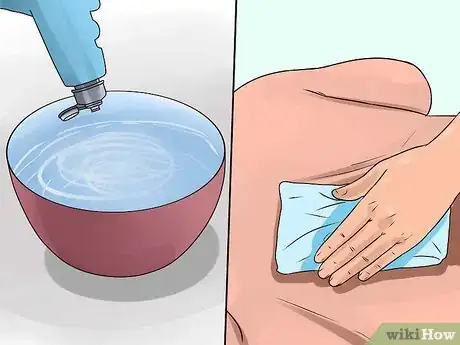
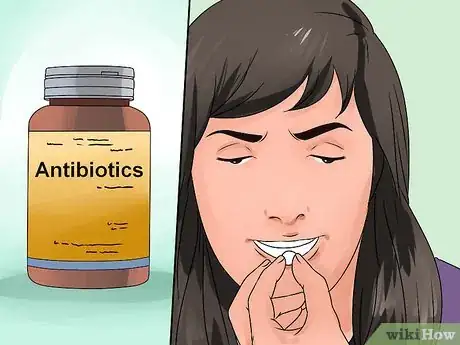
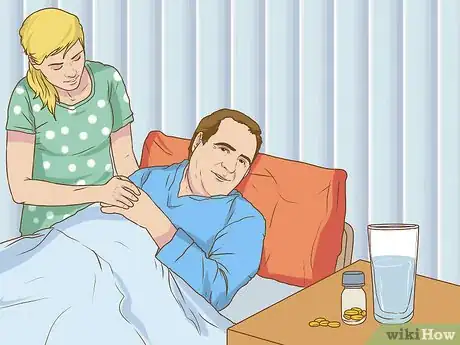
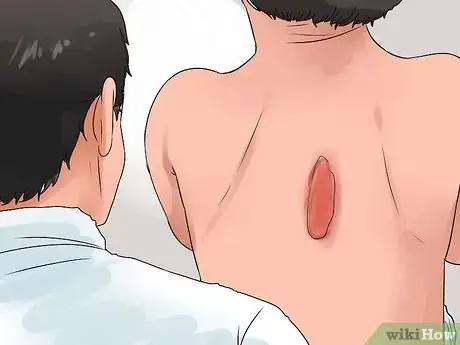





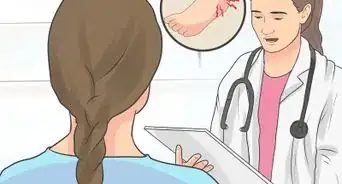
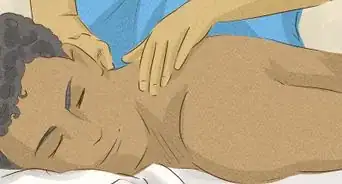

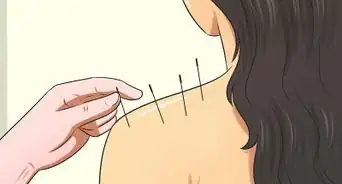
















































Medical Disclaimer
The content of this article is not intended to be a substitute for professional medical advice, examination, diagnosis, or treatment. You should always contact your doctor or other qualified healthcare professional before starting, changing, or stopping any kind of health treatment.
Read More...